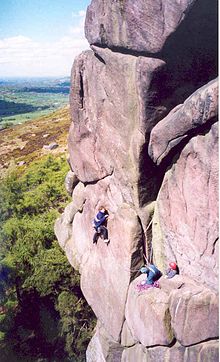 |
Climbing up the walls again |
Effective Climbing Training
Effective Climbing Training
Complete Training Manual for Any Climber
I peeled off again falling onto the mat. I lay there sprawled wondering if I can ever get better. I’m in pretty good shape and strong, but V1 was my top gear. I even had to fight for the easy routes. I’m watching this guy crush a V7 like a circus monkey. I wanted to do that. I wanted to climb as well as I can walk.
Climbing is exactly what you need to do to get better at climbing (it will take some time), but if you need to get better faster you have to train for it. Climbing just by itself will often lead to huge plateaus. After hitting that road block I researched the internet to see if I could any information that would help me get better. And that’s when I found Brian West’s “Climbing to the Top.”
Brain West was just like me, he struggled and struggled to get better. First he talked to climbers at the gym, and all they said was “climb,” and that didn’t help him much. Everything changed when he got a hold of experts, and they taught him what he was doing wrong and what he should do RIGHT! This book is different because West went through the tough growing pains of not being a naturally good climber like I have. And most importantly he overcame them all with the right kind of climbing training. Look at his amazing eBook and you can too.

You will learn:
· A complete training program for your favorite style of climbing.
· 3 Key Principles to create any training program, without falling flat.
· 7 Secrets to climbing smart and effectively.
· Increase your pull strength by 10-30% fast.
· A proven method to increase your flexibility, and step-by-step process of keeping yourself injury free.
· Design and fine tune your diet to climb your absolute best.
I know that you may have some concerns about this eBook. I know I did, so allow me to address them. The first thing that I noticed is the book contained no pictures. After reading it though I realized that I already know the exercises described, I didn’t need pictures to understand it. Plus his descriptions are well written. Mr. West also didn’t want to overload your computer with megabytes of information that pics commonly take up. Not only that his nearest competitor has no pics either and Brian’s eBook is half the price.
Another thing I was worried about was, is it accurate? I’ve personally used it and my climbing ability has already jumped forward in both technique and personal strength. If you follow Brian’s advice you will become a much better climber, and fast! You will progress three grades better just like the book says.
And if you’re still having reservations you have the 60 day ‘Can’t Lose’ money back guarantee. Here’s what Brian says:
60 Day "Can't Lose" Guarantee

If in the next 60 days you don't improve your climbing by 3-7 grades...if other rock climbers don't beg you to share your rock climbing training secerts...if your friends and family don't corner you and DEMAND to know what your 'secret' is for quickly becoming a better stronger rock climber...
...I'll buy the Training for Rock Climbing Course back from you and...
If you’re still having reservations read what Tim Jenkins a customer and enthusiastic reader of the eBook.
“All I can say is THANK YOU! This info is priceless... In less than 1 week after learning about your training and climbing system, I improved my climbing and strength! I'm so surprised (I mean shocked!) at how unbelievably easy this is and I can't wait to try out the other techniques and training ideas. Now I wonder why didn't someone tell me about this sooner?"
- TIM JENKINS
With this order you will be the talk of the climbing gym and the rock alike. If you follow Brian’s Advice you will also feel as good as you look on the wall all day long. Today you could begin your journey of learning to master climbing in the comfort of your own home in 15 minutes or less.
The Insiders
Saturday, June 2, 2012
The Campus Board
Rock Climbing from Wikipedia
| Rock climbing |
|---|
| History |
Contents [hide] |








No comments:
Post a Comment